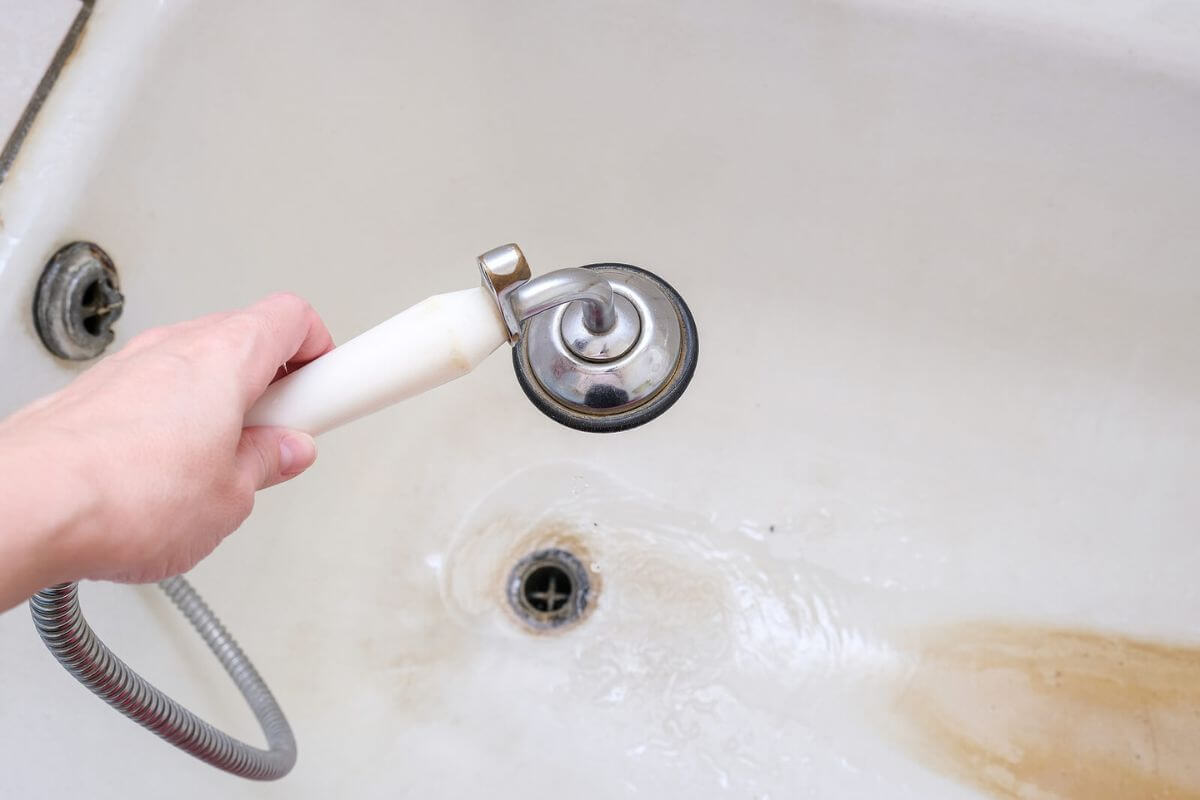There’s nothing quite as relaxing as a warm bath at the end of a long day. But when you turn on the tap and find your bathwater has a yellowish tint, it can be a cause for concern. Yellow bathwater is not only aesthetically unappealing but may also signal underlying issues with your water supply. In this comprehensive guide, we’ll explore the potential causes of yellow bathwater and provide you with practical steps to fix it and enjoy clear, clean baths once again.
Common Causes of Yellow Bathwater
Before addressing the issue, it’s essential to identify the potential causes of yellow bathwater. Common factors include:
1. Rust and Iron Deposits:
- Rust particles and iron deposits in your plumbing system can cause water discoloration, resulting in yellow bathwater. This issue is particularly common in homes with older pipes.
2. Sediment and Minerals:
- Sediment, minerals, and trace elements in your water source can sometimes lead to discoloration. High concentrations of minerals like iron, manganese, or sulfur can contribute to yellow water.
3. Water Supply Issues:
- Occasionally, water discoloration may be due to problems with the municipal water supply. Issues with the water treatment process can affect the water’s color and quality.
Steps to Fix Yellow Bathwater
If you’re dealing with yellow bathwater, follow these steps to identify and resolve the issue:
1. Contact Your Water Supplier:
- If you suspect the problem is related to the municipal water supply, contact your water supplier. They can provide information on any ongoing maintenance or issues that may be affecting the water quality.
2. Flush the System:
- Start by running cold water in your bathtub for about 15 minutes. This can help flush out any sediment or rust particles that may be causing the discoloration.
3. Check for Corrosion:
- Inspect your plumbing system for signs of corrosion, especially if you have older pipes. Rusty pipes or fixtures can leach iron into the water, leading to yellowing. If you discover corroded pipes, consider replacing them.
4. Install a Water Filtration System:
- If you frequently experience water quality issues, consider installing a water filtration system. These systems can help remove impurities, sediments, and minerals from your water, improving its quality and clarity.
5. Test Your Water:
- If the issue persists, consider having your water tested. This can help identify specific contaminants or minerals in your water, allowing you to choose an appropriate water treatment method.

Water Treatment Methods
Based on the results of your water test, you can implement one of the following water treatment methods to fix yellow bathwater:
1. Water Softeners:
- Water softeners are effective at removing minerals like iron, manganese, and calcium from your water, preventing discoloration and improving water quality.
2. Iron Removal Filters:
- Iron removal filters are specifically designed to address issues related to iron and rust in the water supply. They can be installed at the point of entry to your home or at specific fixtures.
3. Oxidizing Filters:
- Oxidizing filters are ideal for addressing sulfur-related odors and discoloration. These filters can effectively remove sulfur and improve water quality.
4. Activated Carbon Filters:
- Activated carbon filters are useful for removing organic contaminants and improving water taste and odor.
Preventive Measures
To prevent yellow bathwater in the future, consider these preventive measures:
- Regularly maintain and replace aging plumbing fixtures and pipes to prevent corrosion.
- Install a water softener or filtration system to proactively address water quality issues.
- Keep an eye on your water supplier’s announcements and maintenance schedules to stay informed about potential water quality concerns.
Experiencing yellow bathwater can be a temporary inconvenience, but with the right steps and preventive measures, you can restore the clarity and quality of your water. Whether it’s addressing issues in your plumbing, installing a filtration system, or working with your water supplier, you can enjoy clean and clear baths once again. Your relaxation time should be spent unwinding in a soothing bath, not worrying about water discoloration.
Enjoy Clean and Clear Baths
Dealing with yellow bathwater can be a temporary inconvenience, but by identifying the cause and implementing the appropriate solutions, you can enjoy clean and clear baths once again. Whether it’s a matter of water treatment, plumbing maintenance, or filtration, addressing the issue ensures that your relaxation time remains as soothing and enjoyable as it should be.
The Importance of Monitoring Water Quality
Water quality is a critical aspect of maintaining a healthy and comfortable home. It not only impacts the aesthetics of your bathwater but also affects your health and the longevity of your plumbing fixtures. Here are a few important reasons to monitor and maintain water quality:
1. Health and Hygiene:
- Clean and clear water is essential for bathing, drinking, and cooking. High mineral content or contaminants can lead to skin issues, allergies, and digestive problems.
2. Appliance Longevity:
- Water with high mineral content can lead to the buildup of scale in appliances like water heaters, reducing their efficiency and lifespan.
3. Aesthetics:
- Water quality affects the appearance and taste of your tap water, as well as the cleanliness of your bathroom fixtures and surfaces.
4. Environmental Impact:
- Treating water quality issues at the source can reduce the need for bottled water, which has a significant environmental impact due to plastic waste.
Yellow bathwater can be a cause for concern, but with the right steps, you can identify the source of the issue and implement effective solutions to enjoy clean and clear baths once more. From addressing plumbing problems to installing filtration systems, maintaining water quality not only ensures a pleasant bathing experience but also contributes to your overall well-being. A healthy and comfortable home starts with the water you use daily.
Restoring Your Water Clarity: How to Fix Yellow Bath Water
There’s nothing quite as relaxing as a warm bath at the end of a long day. But when you turn on the tap and find your bathwater has a yellowish tint, it can be a cause for concern. Yellow bathwater is not only aesthetically unappealing but may also signal underlying issues with your water supply. In this comprehensive guide, we’ll explore the potential causes of yellow bathwater and provide you with practical steps to fix it and enjoy clear, clean baths once again.
Common Causes of Yellow Bathwater
Before addressing the issue, it’s essential to identify the potential causes of yellow bathwater. Common factors include:
1. Rust and Iron Deposits:
- Rust particles and iron deposits in your plumbing system can cause water discoloration, resulting in yellow bathwater. This issue is particularly common in homes with older pipes.
2. Sediment and Minerals:
- Sediment, minerals, and trace elements in your water source can sometimes lead to discoloration. High concentrations of minerals like iron, manganese, or sulfur can contribute to yellow water.
3. Water Supply Issues:
- Occasionally, water discoloration may be due to problems with the municipal water supply. Issues with the water treatment process can affect the water’s color and quality.
Steps to Fix Yellow Bathwater
If you’re dealing with yellow bathwater, follow these steps to identify and resolve the issue:
1. Contact Your Water Supplier:
- If you suspect the problem is related to the municipal water supply, contact your water supplier. They can provide information on any ongoing maintenance or issues that may be affecting the water quality.
2. Flush the System:
- Start by running cold water in your bathtub for about 15 minutes. This can help flush out any sediment or rust particles that may be causing the discoloration.
3. Check for Corrosion:
- Inspect your plumbing system for signs of corrosion, especially if you have older pipes. Rusty pipes or fixtures can leach iron into the water, leading to yellowing. If you discover corroded pipes, consider replacing them.
4. Install a Water Filtration System:
- If you frequently experience water quality issues, consider installing a water filtration system. These systems can help remove impurities, sediments, and minerals from your water, improving its quality and clarity.
5. Test Your Water:
- If the issue persists, consider having your water tested. This can help identify specific contaminants or minerals in your water, allowing you to choose an appropriate water treatment method.
Water Treatment Methods
Based on the results of your water test, you can implement one of the following water treatment methods to fix yellow bathwater:
1. Water Softeners:
- Water softeners are effective at removing minerals like iron, manganese, and calcium from your water, preventing discoloration and improving water quality.
2. Iron Removal Filters:
- Iron removal filters are specifically designed to address issues related to iron and rust in the water supply. They can be installed at the point of entry to your home or at specific fixtures.
3. Oxidizing Filters:
- Oxidizing filters are ideal for addressing sulfur-related odors and discoloration. These filters can effectively remove sulfur and improve water quality.
4. Activated Carbon Filters:
- Activated carbon filters are useful for removing organic contaminants and improving water taste and odor.
Preventive Measures
To prevent yellow bathwater in the future, consider these preventive measures:
- Regularly maintain and replace aging plumbing fixtures and pipes to prevent corrosion.
- Install a water softener or filtration system to proactively address water quality issues.
- Keep an eye on your water supplier’s announcements and maintenance schedules to stay informed about potential water quality concerns.
Enjoy Clean and Clear Baths
Dealing with yellow bathwater can be a temporary inconvenience, but by identifying the cause and implementing the appropriate solutions, you can enjoy clean and clear baths once again. Whether it’s a matter of water treatment, plumbing maintenance, or filtration, addressing the issue ensures that your relaxation time remains as soothing and enjoyable as it should be.
The Importance of Monitoring Water Quality
Water quality is a critical aspect of maintaining a healthy and comfortable home. It not only impacts the aesthetics of your bathwater but also affects your health and the longevity of your plumbing fixtures. Here are a few important reasons to monitor and maintain water quality:
1. Health and Hygiene:
- Clean and clear water is essential for bathing, drinking, and cooking. High mineral content or contaminants can lead to skin issues, allergies, and digestive problems.
2. Appliance Longevity:
- Water with high mineral content can lead to the buildup of scale in appliances like water heaters, reducing their efficiency and lifespan.
3. Aesthetics:
- Water quality affects the appearance and taste of your tap water, as well as the cleanliness of your bathroom fixtures and surfaces.
4. Environmental Impact:
- Treating water quality issues at the source can reduce the need for bottled water, which has a significant environmental impact due to plastic waste.
Yellow bathwater can be a cause for concern, but with the right steps, you can identify the source of the issue and implement effective solutions to enjoy clean and clear baths once more. From addressing plumbing problems to installing filtration systems, maintaining water quality not only ensures a pleasant bathing experience but also contributes to your overall well-being. A healthy and comfortable home starts with the water you use daily.
Conclusion
Experiencing yellow bathwater can be a temporary inconvenience, but with the right steps and preventive measures, you can restore the clarity and quality of your water. Whether it’s addressing issues in your plumbing, installing a filtration system, or working with your water supplier, you can enjoy clean and clear baths once again. Your relaxation time should be spent unwinding in a soothing bath, not worrying about water discoloration.
Frequently Asked Questions (FAQs)
Let’s address some common questions that may arise when dealing with yellow bathwater:
1. Is yellow bathwater safe to use?
In most cases, yellow bathwater is safe for bathing and poses no health risks. However, it’s essential to determine the cause of the discoloration and take appropriate steps to address it.
2. Can yellow bathwater stain my bathtub or fixtures?
Yes, if your bathwater contains high levels of iron or other minerals, it can potentially stain your bathtub, sink, or fixtures over time. Regular cleaning can help prevent or reduce these stains.
3. Why is only the hot water yellow, while the cold water is clear?
The discoloration may be more noticeable in hot water due to the way certain minerals or sediments react with heat. If you observe this, it could be a sign that the issue is specific to your hot water system.
4. How can I distinguish between temporary and persistent water discoloration?
Temporary discoloration is often caused by factors like water supply maintenance or a disturbance in the pipes. If the issue persists for an extended period, it may be due to a more significant problem, such as corroded pipes.
5. Are there any home remedies to fix yellow bathwater?
While some home remedies like flushing the system or using a temporary filter may help in certain situations, it’s advisable to address the issue at its source with professional solutions. Water quality problems may require specialized equipment for long-term solutions.
6. Can I use water treatment tablets or chemicals to fix yellow bathwater?
While there are water treatment tablets and chemicals available, their effectiveness depends on the specific issue with your water. It’s generally best to conduct a water test and consult with a water treatment specialist for tailored solutions.
7. How can I prevent yellow bathwater in the future?
To prevent yellow bathwater, consider installing a water filtration system, maintaining your plumbing, and staying informed about your water supplier’s maintenance schedules. Regular water testing and system checks can also help you stay ahead of potential issues.



